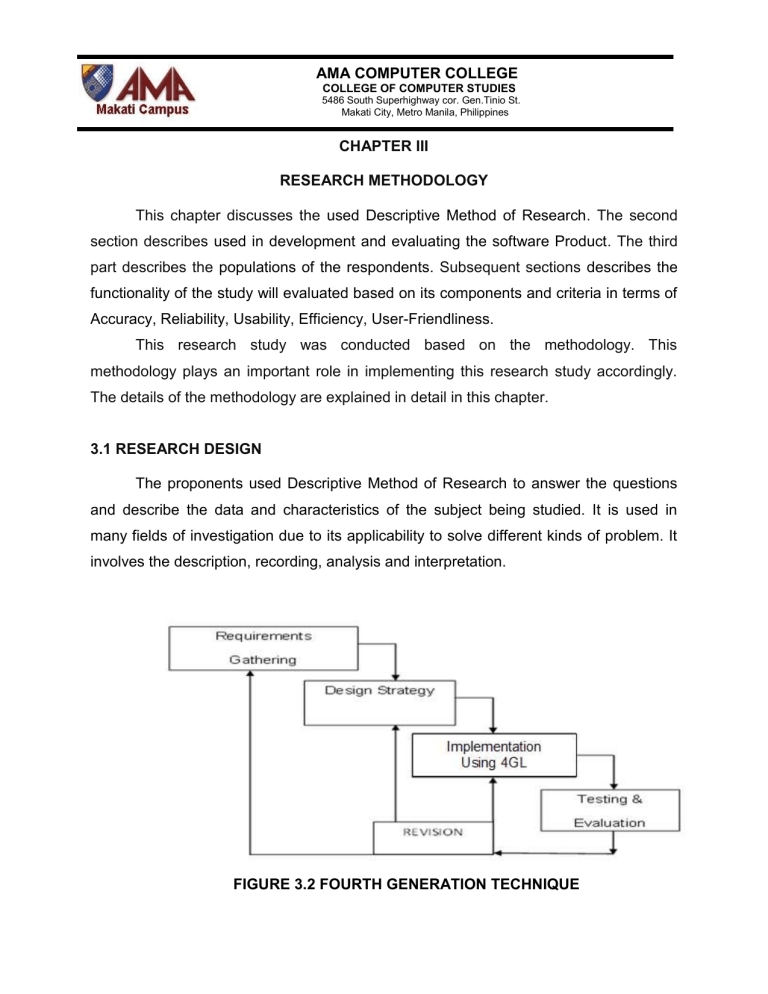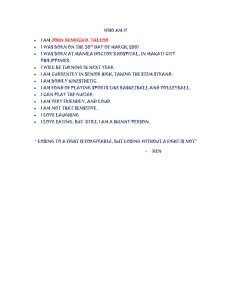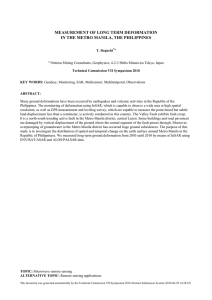
AMA COMPUTER COLLEGE COLLEGE OF COMPUTER STUDIES 5486 South Superhighway cor. Gen.Tinio St. Makati City, Metro Manila, Philippines CHAPTER III RESEARCH METHODOLOGY This chapter discusses the used Descriptive Method of Research. The second section describes used in development and evaluating the software Product. The third part describes the populations of the respondents. Subsequent sections describes the functionality of the study will evaluated based on its components and criteria in terms of Accuracy, Reliability, Usability, Efficiency, User-Friendliness. This research study was conducted based on the methodology. This methodology plays an important role in implementing this research study accordingly. The details of the methodology are explained in detail in this chapter. 3.1 RESEARCH DESIGN The proponents used Descriptive Method of Research to answer the questions and describe the data and characteristics of the subject being studied. It is used in many fields of investigation due to its applicability to solve different kinds of problem. It involves the description, recording, analysis and interpretation. FIGURE 3.2 FOURTH GENERATION TECHNIQUE AMA COMPUTER COLLEGE COLLEGE OF COMPUTER STUDIES 5486 South Superhighway cor. Gen.Tinio St. Makati City, Metro Manila, Philippines The proponents used the 4th Generation Technique because it enables developers to easily determine problems with the system. The first phase is the information gathering. In this phase, the proponents gather data information needed in working with the system. The second phase is the design strategy. In this phase, it allows the user to show a monitor screen display on how the program runs with the environment. The third phase is the implementation of 4GL. In this phase, it allows the user to deals with the changeover to a new or improved system. The last phase is the Testing and Evaluation. In this phase, it allows the user to fully test and evaluate the software system. 3.2 Method used in development and evaluating the system The researcher uses “descriptive Development Study” as a research design strategy. The purpose of this of this design is to describe the nature of a situation as it exists at the time of the study and to explore the course of particular phenomena. At the same time, The Fourth generation techniques (4gt) were used as the research paradigm where all activities were based on the steps involved. The researcher gathered factual information through conducting informal interview from people exposed to the new trend technology in order for the proponent to get added information or reviews on the chosen study. Some information were found on from different sources such as online materials, libraries, articles and other source material that is significant to the study. 3.3 Respondents of the studies The populations of the respondents are composed of Casual Gamer and Hardcore Gamer who are beneficiaries of software. Hardcore Gamer are knowledgeable and wide range of interest while Casual Gamer compose of mobile users that have less interest about mobile games and don’t own any handsets. 21 AMA COMPUTER COLLEGE COLLEGE OF COMPUTER STUDIES 5486 South Superhighway cor. Gen.Tinio St. Makati City, Metro Manila, Philippines Table 3.1 Sample population of the Respondents Respondent No. in total Percentage Hardcore Gamer 40 80% Casual Gamer 10 20% Total 50 100% 3.4 Data gathering tools The proponents gathered the necessary information for the study by conducting actual survey to those people who have more or less knowledge about games. At the same time, the respondents were also requested to answer questionnaires. Eventually, the proponents tabulated the results of the survey from each question which able to help analyzing the problem of the study. Other data was also gathered by the researchers from books, magazine, periodicals, and internet. 3.4.1 Instrument used The proponent prepares a set of questionnaire to be distributed to the respondent. The questionnaire will be consisting of a question that is related to the study. The functionality of the study will be determined through the questionnaires. The software will be evaluated based on its components and criteria in terms of Accuracy, Reliability, Efficiency, and User-Friendliness. 22 AMA COMPUTER COLLEGE COLLEGE OF COMPUTER STUDIES 5486 South Superhighway cor. Gen.Tinio St. Makati City, Metro Manila, Philippines 3.5 Statistical Treatment The arithmetic mean, or simply the mean, is the most familiar among the measures of position of central tendency. Sometimes, we refer the mean as the average. Arithmetic Mean is the quotient of the sum of two or more quantities divided by the number of quantities; Webster Comprehensive Dictionary. Average is the quotient of any sum divided by the number of its terms; Webster Comprehensive Dictionary. Standard Deviation is the square root of the arithmetic average of the squares off all deviations form the mean value of series of observation; Webster Comprehensive Dictionary Percentage is used in manipulating the data to determine the present of distribution of the certain population of sample. Ranking enforced the description of percentage. It shows the importance of the position of the term used. Lickert’s scale will be used virtual interpretation that will be used in evaluating the proposed software. 23 AMA COMPUTER COLLEGE COLLEGE OF COMPUTER STUDIES 5486 South Superhighway cor. Gen.Tinio St. Makati City, Metro Manila, Philippines TABLE 3.2 LICKERT’S SCALE TABLE INTERVAL RATING INTERPRETATION 4.21-5.00 5 Strongly Agree (SA) 3.41-4.20 4 Agree (A) 2.61-3.40 3 Neutral (N) 1.81-2.60 2 Disagree (D) 1.00-1.80 1 Strongly Disagree (SD) T-TEST METHOD: T- Test is often called Student's T test in the name of its founder "Student". T test is used to compare two different set of values. It is generally performed on a small set of data. T test is generally applied to normal distribution which has a small set of values. This test compares the mean of two samples. T test uses means and standard deviations of two samples to make a comparison. The formula for T test is given below: 24 AMA COMPUTER COLLEGE COLLEGE OF COMPUTER STUDIES 5486 South Superhighway cor. Gen.Tinio St. Makati City, Metro Manila, Philippines The formula for the t-test is a ratio. FIGURE 3.3 tcomputed s pooled x1 x 2 1 1 s pooled n1 n2 n 1 s n 1 s 1 2 1 2 n1 n2 2 Where: X1 = mean of the first sample X2 = mean of the second sample S1 = standard deviation of the first sample S2 = standard deviation of the second sample N1 = number of items of the first sample N2 = number of items of the second sample 25 2 2 x x 2 s2 i n 1


